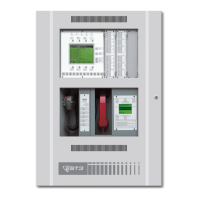Access control applications
3.4 EST3 Installation and Service Manual
The maximum run from a CRC to the 3-SAC is 4,000 ft
(1,220 m) at 25 pF/ft. The maximum total capacitance of the run
is 0.1 μF, and the maximum total resistance is 52 Ω.
CRC Card Reader Controller
The Card Reader Controller (CRC) module performs all access
decision processing. Each CRC stores a database and is capable
of granting or denying entry without external communication. If
entry is granted, the CRC applies or removes power to the strike
or maglock to unlock the door. The CRC is also capable of
unlocking a door by activating a manual push button.
Each CRC stores an access database of users and events for the
door it controls. The CRCXM model features enhanced storage
capacity. (Refer to the product installation sheets for quantities.)
Each CRC has terminals that support:
• Two card readers, typically one inside and one outside the
door
• One lock device, either strike or maglock type
• Two input circuits for devices such as request to exit
detectors, door contacts, or motion detectors
• One output circuit with N.O and N.C. contacts for auxiliary
devices, such as door openers
With the addition of an internal battery, the CRC can continue
processing access events even if there is a loss of communication
or power.
CRC options
CRCSND CRC Sounder
The CRC Sounder is a small horn that mounts inside the card
reader controller module. The sounder operates if an emergency
exit door is opened without an exit request and can also indicate
that a door has been left open.
The CRC Sounder can be programmed, using rules written in the
SDU. Further, the ACDB program can control several operating
parameters of the sounder.
CRCRL CRC Accessory Relay
The CRCRL is an accessory relay for the CRC (or CRCXM)
Card Reader Controller. Use the CRCRL in conjunction with an
external power supply to control a lock which requires voltage or
current outside the CRC's operating range.

